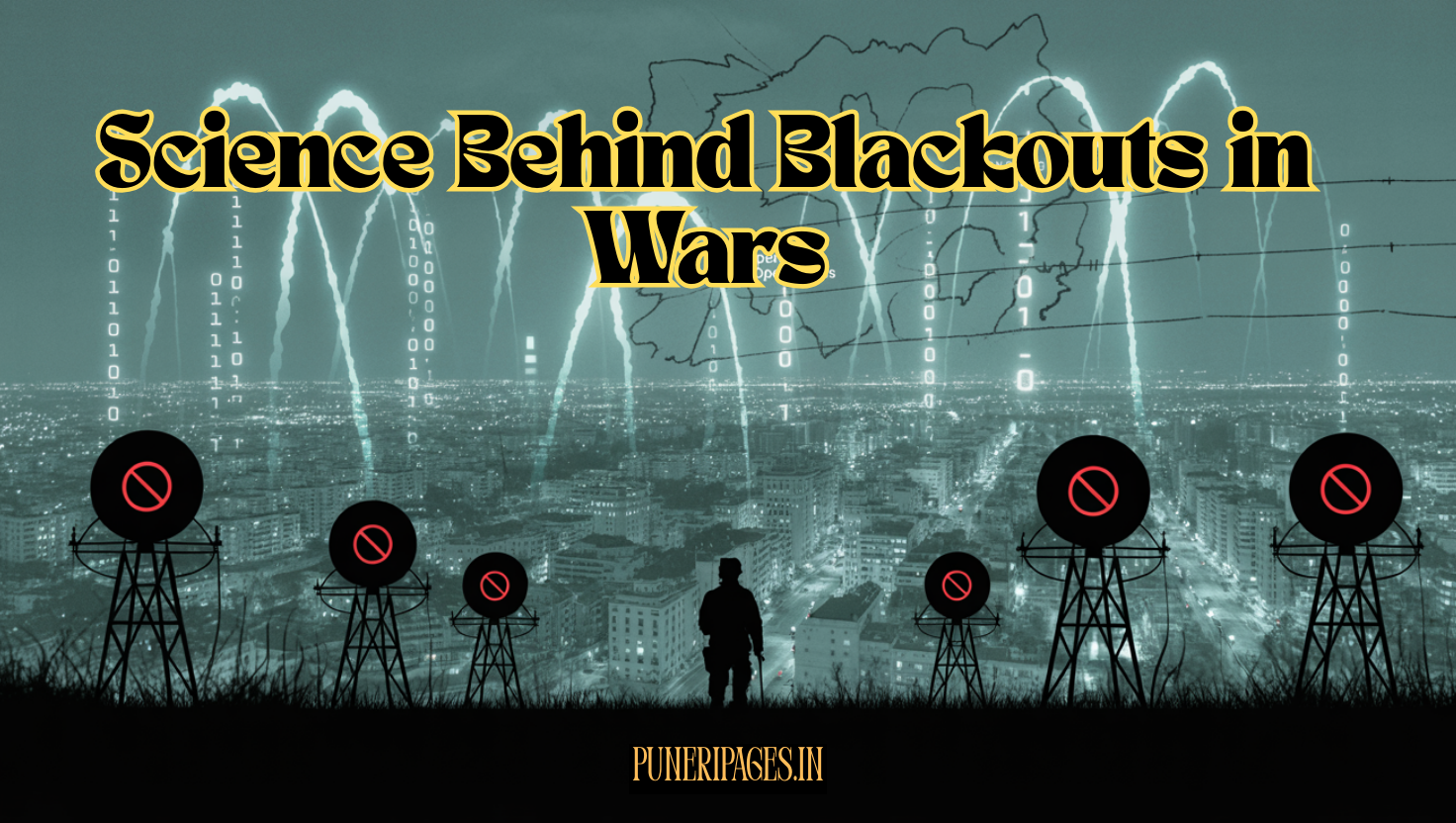
Cover illustration depicting strategic blackout tactics: communication jamming, infrastructure concealment, and digital warfare overlays.
The Science Behind Blackouts in Wars revolves around four key strategic objectives: disrupting enemy communications by inducing radar and radio blackouts through plasma and electromagnetic effects, employing physical and digital means to blind adversaries’ sensors, minimizing visible infrastructure signatures to thwart aerial targeting, conserving precious electrical power for military systems via deliberate civilian‐sector load shedding, and leveraging confusion to sap enemy morale and decision‑making under stress. Together, these methods illustrate how blackout tactics serve both technological and human dimensions of modern warfare.
Table of Contents
Science Behind Blackouts in Wars: Cutting Enemy Communication
Blackouts can sever adversary command‑and‑control by creating plasma blackout zones that absorb or scatter radar and radio waves Wikipedia.

- Nuclear and High‑Altitude Detonations: A thermal fireball from a nuclear burst produces ionized air with electron densities that refract or block radar signals over hundreds of kilometers, a phenomenon known as “nuclear blackout .
- Electromagnetic Pulse (EMP): Non‑nuclear EMP generators induce voltage surges and create transient plasmas in the atmosphere, disabling electronic receivers and transmitters without the need for kinetic strikes.
- Cyber‑Physical Jamming: Combined cyberattacks and kinetic strikes (e.g., the 2022 Sandworm operation in Ukraine) have simultaneously targeted SCADA systems and power substations to induce rolling blackouts, effectively jamming both communications networks and civilian infrastructure.
- Austere Communications Doctrine: Great‑power militaries integrate cyber, antispace, and electronic‑warfare tools to “blind and deafen” opponents, deliberately imposing communication blackouts to degrade situational awareness.
Hiding Infrastructure from Aerial Targeting
Physical blackouts remain vital for visual stealth against bombing and reconnaissance aircraft.
- Darkness Against Bombers: In both World Wars, cities and coastal installations extinguished lights to prevent crews from visually identifying targets, forcing enemy aviators to rely on primitive navigation aids.
- Submarine Silhouettes: Coastal blackouts during WW II shielded merchant vessels from U‑boat periscopes by denying light that could silhouette ships against illuminated shorelines .
- Radar Countermeasures: Modern stealth tactics may include deploying smoke screens and decoy lights, further complicating thermal and optical sensors even in reduced‑light conditions.
- Case Study – London Blitz: Strict blackout regulations in 1940–41 showed that reduced illumination lowered bombing accuracy by up to 30 %, forcing Luftwaffe crews to bomb randomly or abort missions Wikipedia.
Energy Conservation for Military Priorities
Strategic blackouts conserve electrical power for critical military assets.
- Load Shedding: Governments have imposed rolling blackouts to shift peak civilian demand away from power plants, freeing capacity for military bases, radar sites, and munitions factories.
- Energy Resilience Drills: The U.S. Army routinely conducts “Cutting the Cord” exercises, simulating grid outages on bases to refine protocols for maintaining readiness with backup generators and microgrids.
- Renewable Microgrids: Forward‑deployed units increasingly rely on solar‑diesel microgrids designed to sustain critical loads during extended blackouts, reducing dependence on vulnerable national grids .
- Strategic Electricity Attacks: Historical analyses warn that indiscriminate attacks on enemy power grids risk undermining war production more than delivering tactical advantage, highlighting the need for measured energy‑targeting strategies.
Psychological Impact: Confusion and Morale
Beyond hardware effects, blackouts exert a psychological toll on adversaries and civilian populations.
- Disrupted Routines: Night‑time blackouts in WW II Britain caused road accidents, crime spikes, and public anxiety, leading to widespread grumbling that chipped away at morale.
- Decision Paralysis: Command staffs deprived of reliable communications and lighting face slower reaction times and increased hesitancy under ambiguous conditions.
- Chaos in Urban Centres: Sudden, unannounced blackouts during insurgencies can trigger stampedes, overwhelm emergency services, and sever trust in local authorities .
- Cognitive Fatigue: Repeated exposure to blackout‑induced stress degrades troops’ and civilians’ resilience, making sustained operations against them more likely to succeed.
Conclusion
Blackouts in warfare harness physical, electronic, and psychological mechanisms to shape the battlespace. From ionospheric plasmas that blind radar to civilian‑sector load management that prioritizes military power, and from coastal blackouts that shield ships to morale‑sapping darkness in cities, blackout science underscores how controlling light and electricity remains a potent force multiplier. Future conflicts will blend traditional blackout methods with cyber‑electronic warfare and resilient energy infrastructures—making mastery of blackout dynamics essential for both offense and defense.






